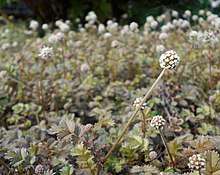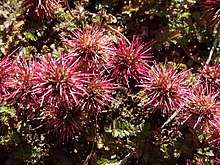Acaena microphylla
Acaena microphylla (common names - bidibid or piripiri,[4] and outside New Zealand, New Zealand-bur)[5] is a small herbaceous, prostrate perennial, in the Rosaceae family native to both the North and South Islands of New Zealand.[2] There are two varieties:
| Acaena microphylla | |
|---|---|
 | |
 | |
| Scientific classification | |
| Kingdom: | Plantae |
| Clade: | Tracheophytes |
| Clade: | Angiosperms |
| Clade: | Eudicots |
| Clade: | Rosids |
| Order: | Rosales |
| Family: | Rosaceae |
| Genus: | Acaena |
| Species: | A. microphylla |
| Binomial name | |
| Acaena microphylla | |
There are no synonyms.[2]
Description
Hooker describes it as "a very small and glabrous species; the leaflets not 1/4 in. long. Capitula very large for the size of the plant, upwards of an inch across, including the spines, which are not barbate, and distinguish it as a species."[3]
Taxonomy and naming
Acaena microphylla was first formally described in 1852 by Joseph Dalton Hooker.[2][3] The genus name (Acaena) is derived from the Ancient Greek word akaina meaning "thorn" or "spine",[7] referring to the spiny calyx of many species of Acaena. The specific epithet, microphylla, derives from the Greek words, mikros (small) and phyllon (leaf) to give an adjective meaning "small-leaved".[8]
Distribution
It is found on both the North Island and South Island of New Zealand.[2]
Conservation status
In 2013, the variety, Acaena microphylla var. pauciglochidiata, was classified as "At Risk - Naturally Uncommon" under the New Zealand Threat Classification System. By 2018 due to an actual decline, the status changed to "At Risk - Declining". (The area of occupancy had decreased to 100 km2 or less, and the predicted decline was 10 to 50%).[1] However, the variety, Acaena microphylla var. microphylla, was classified as "Not Threatened", in 2004, 2009 and 2012[4] and again in 2018.[1]
References
- Lange, Peter J. de; Rolfe, Jeremy R.; Barkla, John W.; Courtney, Shannel P.; Champion, Paul D.; Perrie, Leon R.; Beadel, Sarah M.; Ford, Kerry A.; Breitwieser, Ilse; Schönberger, Ines; Hindmarsh-Walls, Rowan (1 May 2018). "Conservation status of New Zealand indigenous vascular plants, 2017" (PDF). New Zealand Threat Classification Series. 22: 9, 53. OCLC 1041649797.
- "Acaena microphylla Hook.f. | Plants of the World Online | Kew Science". Plants of the World Online. Retrieved 7 January 2020.
- Hooker, J.D. (1853). "The botany of the Antarctic voyage of H.M. discovery ships Erebus and Terror in the Years 1839-1843 :under the command of Captain Sir James Clark Ross". p. 55.

- "Acaena microphylla var microphylla". New Zealand Plant Conservation Network. Retrieved 8 January 2020.
- "Acaena microphylla Hook.f." www.gbif.org. Retrieved 7 January 2020.
- "Acaena microphylla var. pauciglochidiata". New Zealand Plant Conservation Network. Retrieved 8 January 2020.
- Brown, Roland Wilbur (1956). The Composition of Scientific Words. Washington, D.C.: Smithsonian Institution Press. p. 796.
- "microphyllus,-a,-um". www.plantillustrations.org. Retrieved 7 January 2020.
External links
- Acaena microphylla occurrence data from Australasian Virtual Herbarium

